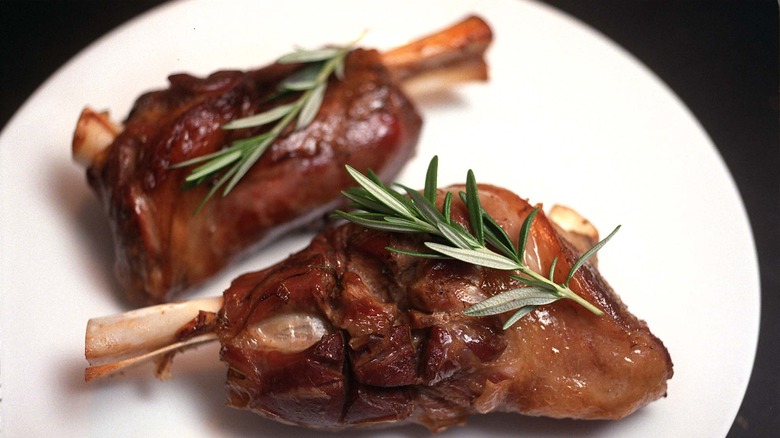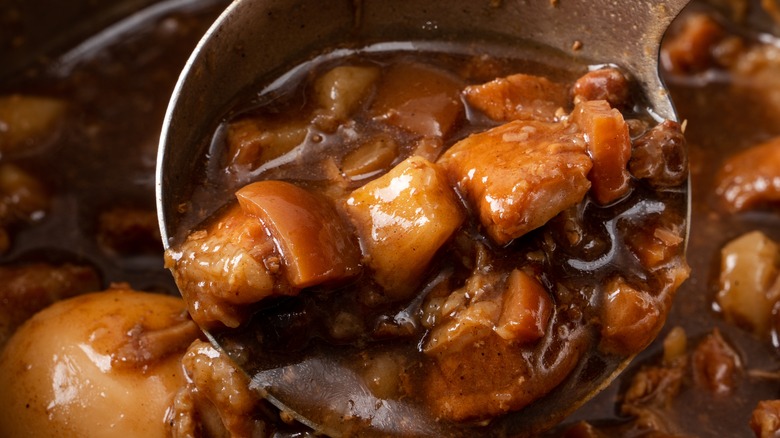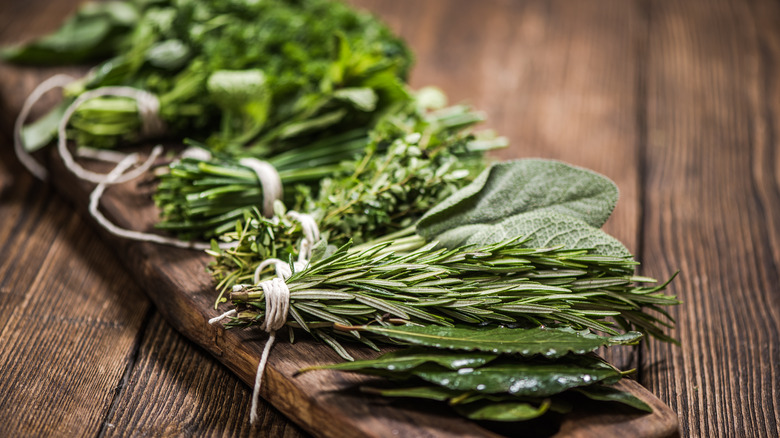The Best Type Of Herb To Cook With Tough Meats
In our modern culture of supermarket shopping, you can pick and choose almost any cut of meat anytime you want. But this of course wasn't always the case. There was a time not so long ago when most people had to learn how to cook all the different cuts of meat so that nothing went to waste, often because they raised the animal themselves.
Today, we call that by a trendy term, "tail-to-nose cooking" (or vice versa, "nose-to-tail"), according to Mashed, and it's grown in popularity among professional chefs who strive for sustainability. At home, however, most of us aren't equipped to cook a whole cow or pig, especially since we can get individual cuts from any butcher.
While you don't have to use up every part of the animal in your own home kitchen, the quickest choice for getting dinner on the table is using softer cuts of meat like chicken breasts, boneless pork loin, and ground beef. There are some very tasty cuts that our ancestors learned to cook out of necessity, however, which are also often cheap (or cheaper), and require little to no cooking skill, just a little extra time to make — the tough cuts (per Thrillist). All you need to know is how to cook and season these tougher pieces of meat.
Low and slow is the way to go
The hands-down best method for tackling any tough cut of meat is cooking it "low and slow," per Thrillist. This could be slow-roasting in the oven, slow cooking over indirect heat as in barbecue, and slowly simmering in a flavored liquid, which is called braising. Slowly cooking the meat breaks down the connective tissue and renders the fat, leaving behind tender tidbits like beef brisket.
The great news about slow cooking is that as long as you know the basic techniques you really don't need a recipe to turn a tough cut into a culinary masterpiece. You also don't need any fancy equipment. A slow cooker is nice to have, but all you really need is just an oven and a large oven-safe pan with a tight-fitting lid to braise. Whether you're making pork ribs, pot roast, or lamb stew, most of the techniques are a matter of simply setting the heat to the proper temperature and then getting hands-off for at least a few hours (sometimes several) to let the meat slowly do its thing.
Because these cooking techniques take a long time, they also require some thoughtful seasoning. Delicate herbs and spices will lose their aromatics through the extended cooking time, so you should choose hearty flavors that will pair well with your chosen cut while also going the distance in the slow cooker.
Herbs for slow cooking
You don't want to spend your money on herbs and spices that you won't be able to taste in your slow-cooked meat, so skip using basil, parsley, chervil, tarragon, and other light herbs. For braising and slow-roasting, look to heartier flavors that can stand up to long heat. Tougher cuts of meat also tend to have stronger flavors and greasier textures (think lamb shank and pork shoulder), so you'll need flavors that can cut through those factors.
Depending on which meat you choose, go for spices and herbs that are whole or on the stem. For example, black peppercorns have no problem standing up to braising or roasting, and the same is true for bay leaves, whole cumin, anise, and annatto seeds. Spices Inc recommends using cayenne and thyme for beef; allspice, caraway, and mustard for pork; and rosemary for turkey, lamb, and chicken.
Rosemary is an all-star because it retains its flavor for a long time, goes well with many types of meat, and its piny, evergreen qualities can counteract the heaviness of fatty cuts. It's also available year-round and lasts for several weeks in the refrigerator (per BBC goodfood). According to The New York Times, rosemary can even reduce some toxins produced by grilling meats. Plus it's easy to use — simply add a sprig or two to your braising liquid, or roughly chop the needles and add to your spice rub.


